The Google Nexus 6P Review
by Andrei Frumusanu on December 16, 2015 8:00 AM ESTDisplay Measurement
One of the more significant characteristics of the Nexus 6P is the device’s AMOLED screen. Similar to last year’s Nexus 6, Google has chosen to employ the 6P with a panel from Samsung. While the Nexus 6’s panel seemed to lack in quality, both power and image quality wise, the 6P’s unit is quite excellent.
The screen is very clear and offers excellent homogeneity. Ever since the first AMOLED devices came out a few years ago Samsung has managed to steadily advance the technology with improvement with each yearly generation. The Nexus 6P’s can be said to rank well among the Note 4 or Note 5 in terms of image quality, and it seems the 6P’s lamination actually provides slightly better viewing angles than what’s found on Samsung’s devices.
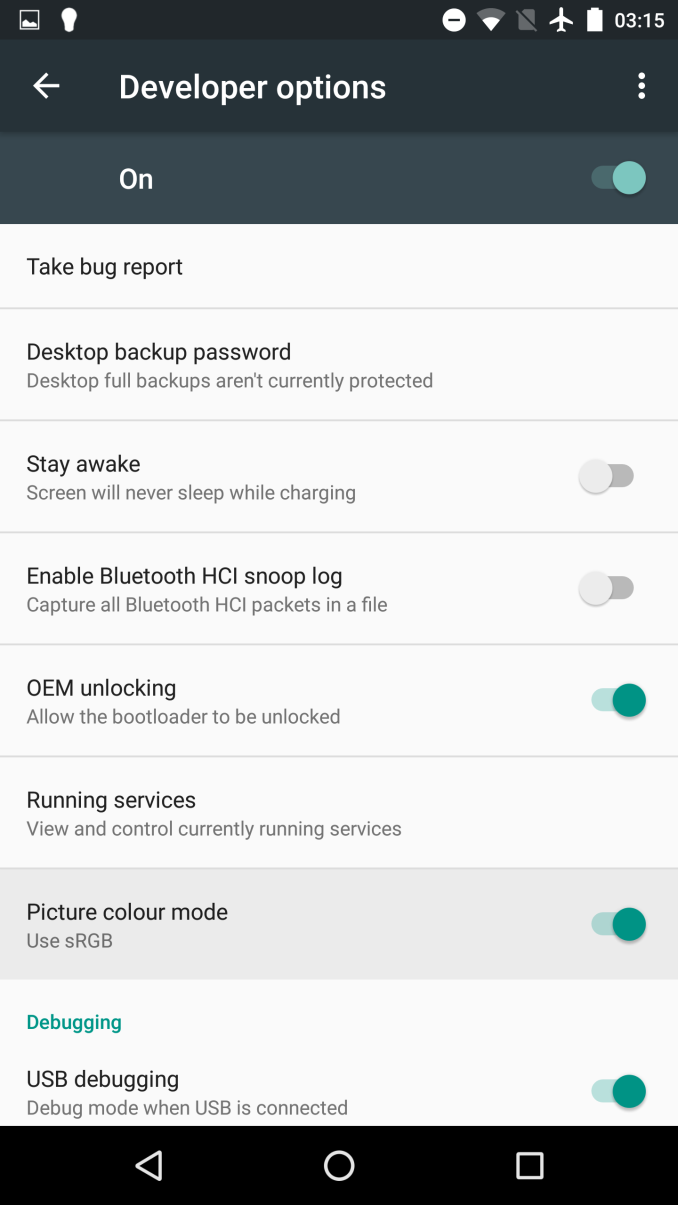
Settings => Developer Options => Picture Colour Mode
Before getting to the results, I'd like to mention that I tested both the device's default colour calibration as well as its sRGB calibration. This setting is rather hidden for the average user: You have to enable the developer options menu by tapping repeatedly on the "Build Number" found in Settings => About Phone, after which the menu will appear under the global settings menu. It's a pity that Google didn't make this option more accessible via the general display settings, but it will be required to access if you care about accurate colour reproduction on the Nexus 6P.
We start by measuring the maxium brightness of the 6P. As always, our display testing is done with an X-Rite i1Pro 2 spectrophotometer as our measurement hardware, in conjunction with SpectraCal's CalMAN software suite and our own workflow to be able to get an accurate display characterization.

The Nexus 6P manages to drive the screen at up to 348nits, a quite satisfactory level of brightness that matches the Note 5’s characteristics. Unlike Samsung’s devices, it seems the Nexus 6P has no overdrive function which vastly increases the luminosity under high ambient light and auto-brightness. Nevertheless, I’ve had no issues whatsoever in terms with outdoor visibility (Although that’s not a very convincing statement for European winters) as the screen offers excellent contrast.
While still on the topic of brightness, I was actually disappointed to discover that the device’s software is set up so that the brightness slider bottoms out at 8.5 cd/m². While doing the power curve measurements I discovered that the panel and driver is actually able to go down as low as 1.5 cd/m², making this one of the rare devices whose panel can go that low. I’ve become accustomed to using phones at around 2 nits at night and in bed, so 8 nits was suddenly brighter than I wished for. Changing the minimum value of the stock brightness slider wouldn’t be a very complicated task so I hope Google considers this for future maintenance releases.
Edit: After further testing I discovered that it's possible to get to 1.5 cd/m², but only if Adaptive Brightness is enabled and one is located in a dark environment, as brightness without AB offsets the range of the brightness slider.
Default:
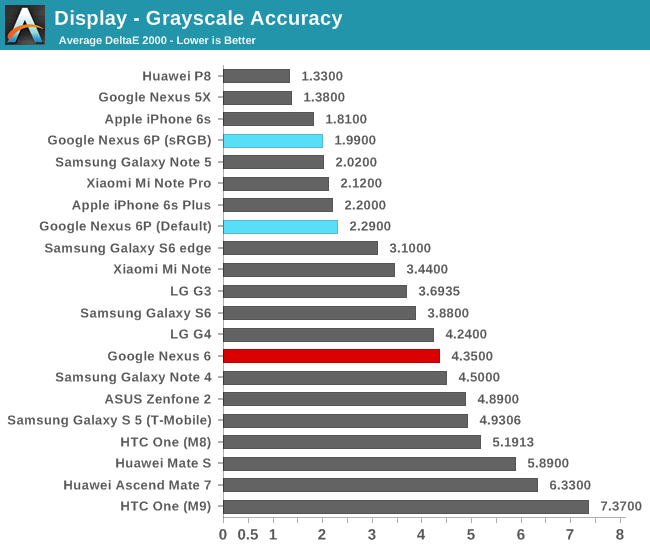
Moving on to the greyscale accuracy tests, we see the Nexus 6P behave very well. At a dE2000 of 1.99 the 6P lands as one of the best devices in terms of accurately reproducing greyscale content. There is however one problem, and that’s the average gamma of 2.41. This causes content to be darker than what it’s supposed to be and also has the effect of making colours seem more saturated. The default colour calibration doesn't differ very much from the calibrated sRGB norm, as it shows only a slight disadvantage with a dE2000 of 2.29.
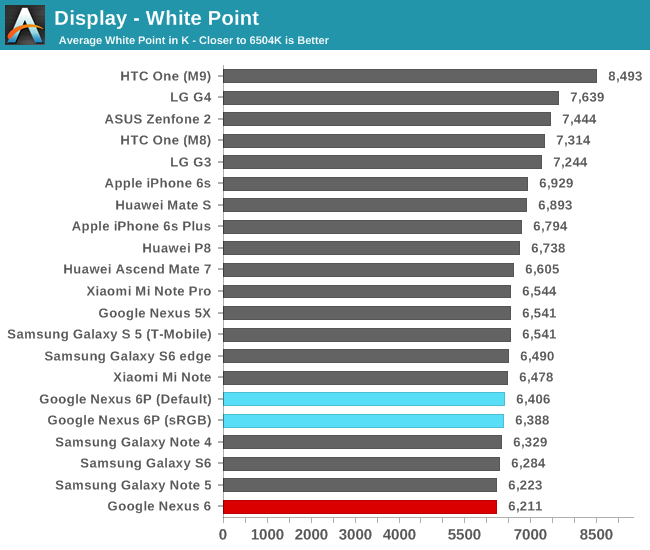
In terms of colour temperature, the 6P is slightly on the warm side as it comes at 6388K at 200cd/m². The latest generations of AMOLED screens seem for some reason to always slightly undershoot the target D65 (6500K) white, making the screen just slightly warmer than it should be.
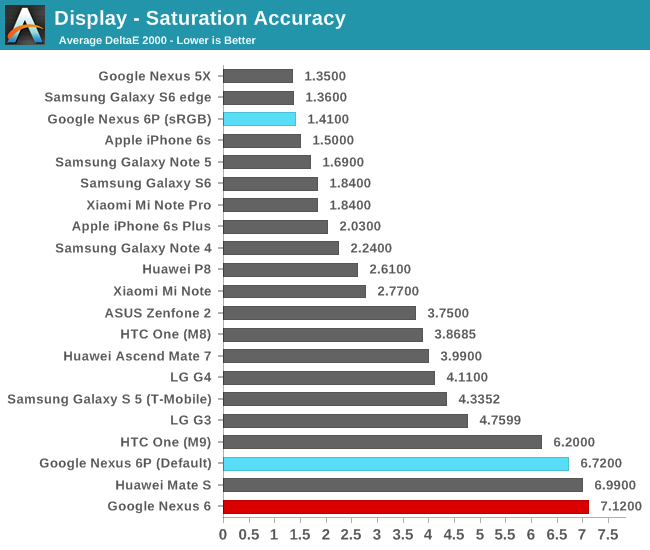
Moving on to the saturation accuracy measurements, we’re presented with some outstanding numbers from the sRGB mode as the 6P manages to deliver an excellent dE2000 of 1.41. At these accuracy levels I would argue that manufacturers would need to resort to individual device colour calibration to be able to provide even better results, as for example even by manually calibrating my own daily driver I wasn’t able to surpass a dE lower than 0.95. Unfortunately the default mode just fares little better than last year's Nexus 6, making for some very saturated colours. I tried to match the reproduced gamut against several standards but I didn't find anything that resembles the Nexus 6P's default mode, meaning this is not an AdobeRGB or DCI large gamut calibration.
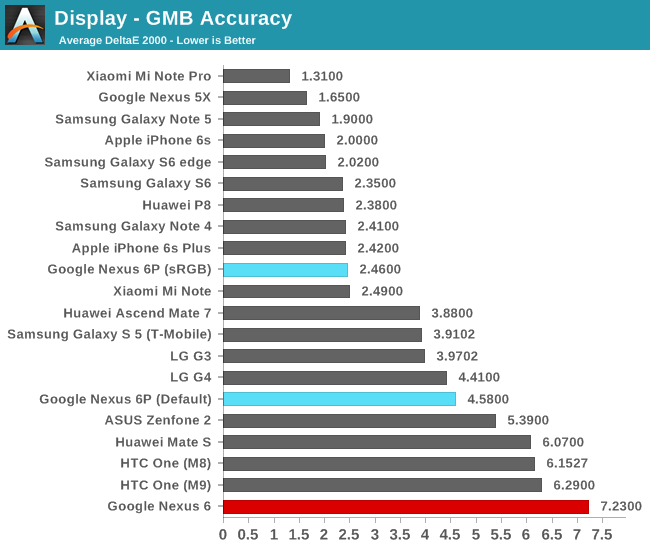
Moving onto the Gretag MacBeth set of commonly encountered colours we see the Nexus 6P fall behind when compared to its excellent greyscale or saturation results. Because the gamma on the 6P’s screen is too high, it causes the luminosity component of colours to be lower and thus, as can be seen in our comparison strip, they will appear darker and slightly more saturated than they should.
On the default settings the GMB accuracy is farther off as expected. There's not much to say here as it's a deliberately inaccurate mode that gives higher priority to vibrant colours as opposed to accuracy.
Overall the Nexus 6 screen ranks among one of the best. It’s a bit of a pity that the gamma calibration was slightly off under the sRGB profile but otherwise the 6P excels in all other metrics. Samsung currently offers the best quality displays and Google and the Nexus 6P takes full advantage of that fact.
Display Power
While we can safely declare that the Nexus 6P offers excellent image quality in its display, one aspect that hasn’t been characterised as much in the past was the power consumption and the resulting luminance efficiency. The Nexus 6 suffered from a quite inefficient panel that resulted in a battery runtime that was lower than expected from a device of its configuration. I was quite worried when I saw that Huawei chose a quite inefficient AMOLED screen for the Mate S, as that proved to be a double-edged sword for the device, as it also offered great image quality but at a great cost in power efficiency.
For the Nexus 6P, getting an accurate power curve for the screen was exceptionally hard as the fuel-gauge of the PMI8994 power management IC of Snapdragon 810 devices updates only rarely and therefor becomes unusable for many power measurements. So to properly characterize the power draw at increasing brightness without spending several hours for each measurement point I hooked up my measurement equipment to the USB power of the 6P. Once a phone’s battery cell is fully charged it will usually switch to be fully powered by the power supplied by the connector as long as it’s able to provide sufficient power. The downside of this method is there’s a significant unknown delta due to the inefficiency of the PMIC converting the input 5V to the system’s internal 3.3V. Nevertheless with some help of some test measurements via the internal fuel gauge I was able to compensate for this difference, which gives us the following power curve:
The Nexus 6P seems to have a base power consumption of around 450mW with a fully black screen, meaning no pixels are powered. This comes in to be similar to what we’ve measured on the Note 4 Exynos, but is still about ~100mW higher than devices featuring more efficient SoC platforms. At maximum brightness, the device consumes about 1.59W, a tad under the 1.7W that the Note 4 used. Some readers might already figure out where I want to go with this, as there’s been plenty of discussion and questions in regard to the efficiency of the panel that will be employed on the Nexus 6P.
To get a better overview, we plot the screen luminance power across several devices in a table and calculate the overall efficiency by dividing that figure by the screen’s area footprint. As a reminder, the screen luminance power is the delta between a screen’s black (or minimal brightness) power to full white at a given brightness, in this case 200cd/m².
| Screen Luminance Power Efficiency 100% APL / White |
||||||
| Device | Screen Luminance Power at 200cd/m² |
Luminance Power (mW) / Screen area (cm²) Efficiency |
||||
| LG G4 | 354 mW | 4.11 | ||||
| Meizu MX4 | 345 mW | 4.14 | ||||
| Huawei P8 | ~341 mW | ~4.43 | ||||
| Meizu MX4 Pro | 386 mW | 4.47 | ||||
| Samsung Galaxy Note 5 | 504 mW | 5.64 | ||||
| Samsung Galaxy S6 | 442 mW | 5.99 | ||||
| Huawei Nexus 6P | ~615 mW | ~6.88 | ||||
| Samsung Galaxy S5 | 532 mW | 7.21 | ||||
| Samsung Galaxy Note 4 | 665 mW | 7.22 | ||||
| Samsung Galaxy S5 LTEA | 605 mW | 8.20 | ||||
| LG Flex 2 | 765 mW | 8.89 | ||||
| Samsung Galaxy S4 | 653 mW | 9.22 | ||||
| Huawei Mate S | ~769 mW | ~9.24 | ||||
At a 200nits and a luminance power of around 615mW, the Nexus 6P’s panel falls in between the Note 4 and the Note 5’s/Galaxy S6’s in terms of efficiency. We can’t clearly attribute any certain emitter generation to the device, but it looks to be about 5% more efficient than the Note 4’s but still a considerable 16% less efficient than the Note 5. It was starting with the Galaxy S6 that I’ve considered AMOLED screens to no longer be in at a disadvantage to LCDs when it comes to efficiency in every-day use-cases. Since the Nexus 6P falls behind that it means we should expect slightly less run-time than comparable LCD devices. Let’s continue on to the battery life results to verify this assessment.






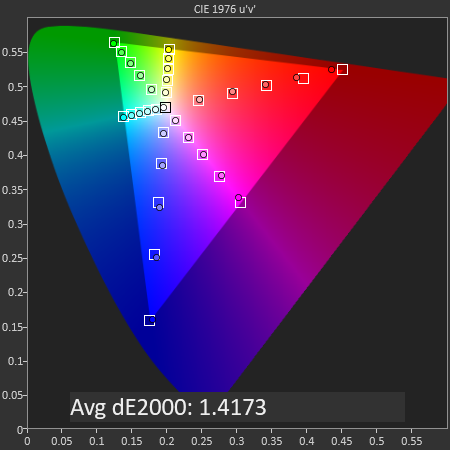
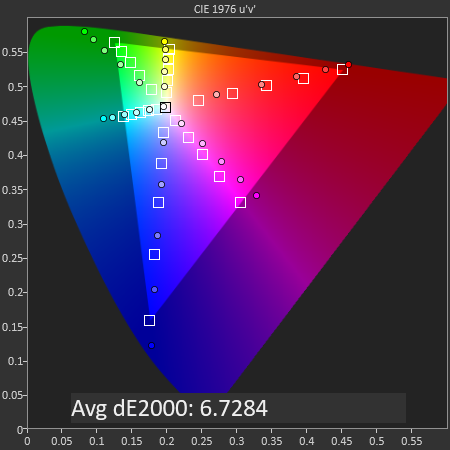

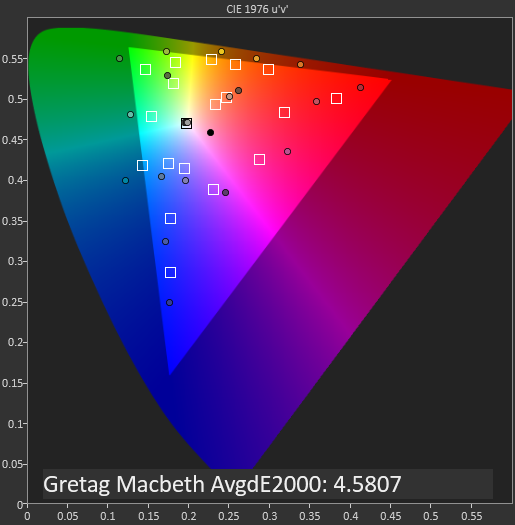


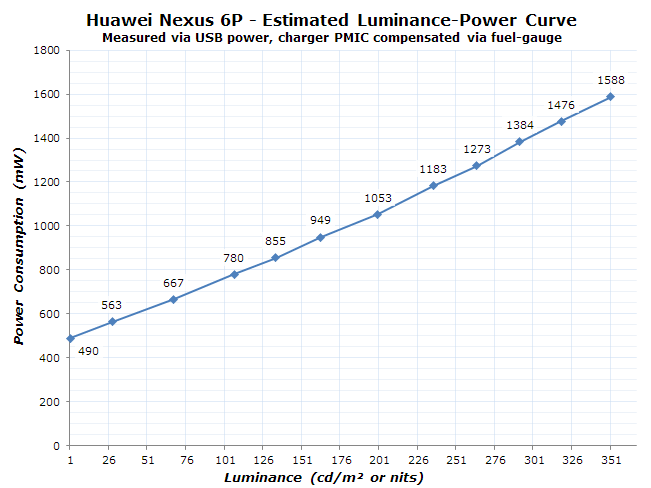








219 Comments
View All Comments
hfm - Thursday, December 17, 2015 - link
Muscle memory is easily learned in short order. Took me a week or two switching from two years of an N5 to get used to the differences. I always ignore those parts of reviews unless it's an obvious exceptionally bad UX choice. These weren't.Nightfall983 - Wednesday, December 16, 2015 - link
I don't understand your need about stock Android not having brightness slider in the notification shade. Swipe the shade down with 2 fingers (or pull down twice), and is right there.hfm - Thursday, December 17, 2015 - link
Not to mention turning off adaptive brightness will get the phone to 500 nits. I leave it on though.. But for this review where numbers are thrown around it should have been done.ChronoReverse - Wednesday, December 16, 2015 - link
Hi Andrei, nice review. You may want to explore /system/etc/thermal-engine.conf to see how the software level thermal throttling is configured. It's pretty interesting how core shutdown and frequency limiting is configured with respect to the temperature. Interestingly enough, GPU throttling is tied to the main temperature sensor as well.You can even remove the file so that the phone relies solely on the fail-safe thermal throttling.
Jeff7181 - Wednesday, December 16, 2015 - link
Would have been nice to see the OnePlus phones in these benchmarks... especially battery life.GPz1100 - Wednesday, December 16, 2015 - link
How about the review including some details on phone call quality, signal reception, etc...?QinX - Wednesday, December 16, 2015 - link
Why? Who uses a phone to call someone and expect a clear reception these days?mystilleef - Wednesday, December 16, 2015 - link
I have both the Note 5 and the 6P and there is no way in hell I'd recommend the Note 5 over the 6P on any universe. The 6P has better battery life, better speakers (yes, contrary, to the reviewer, front facing speakers make a huge difference), better camera (especially low light indoor shots), better MEMORY MANAGEMENT, a better OS, and just a far better user experience.Anyone telling me TouchWiz is better than Stock Android is just delusional. I can't take that person seriously, and I don't think anyone should. TouchWiz has horrible, horrible, horrible memory management especially on the S6 and Note 5. If you enjoy your browser tabs and apps reloading every time you blink, or you fancy random crashes due to memory mismanagement, get the Note 5.
Yes, I own the Note 5, and used it exclusively before I got the 6P.
The ONLY thing great about the Note 5 are the camera and display. That's it. TouchWiz is a curse to Android so much so that there are rumors that Samsung is in talks with Google to help them fix, or optimize, TouchWiz.
I choked on my food when Andrei recommended the Note 5 over the 6p for non-US users. Are you serious, Andrei? Did you use the Note 5 for any extended period of time? The only way I can recommend the Note 5 is if you're willing to flash CM on it.
The Note 5 has been one of the most unstable and unreliable Android devices I've ever used. I regretted selling my Nexus 6 for it. I read all the hype here and on the Internet about the Note 5 and fell for it. As a matter of fact, I plan on getting a Nexus 6 as a backup device and using it instead of the Note 5. Heck even the Nexus 6 performs better than the Note 5, and no one can convince me that TouchWiz is not the culprit.
In what universe is TouchWiz a better user experience than stock Android? Slide down the notification drawer on your 6p and do the same on your Note 5, that's all you need to know about the user experience of either devices. And I'm not even going to talk about the stutter and lag that begins to creep in after a few days of using any TouchWiz device.
I enjoyed the review, but sheesh, it's hard for me to trust the taste or opinion of anyone recommending TouchWiz over stock Android. That, unfortunately, tainted the review for me. A review I'd have otherwise held in high regard.
VnnAmed - Wednesday, December 16, 2015 - link
And if you need to flash CM on Note 5 remember that you will trip KNOX. Or just staywith N6P and flash away since their warranty is not bootloader state dependent. @Andrei Frumusanu One thing that this review didn't mention is that Nexus devices are flash friendly. Why would I buy one of those if not for long-term support and ability to change ROMs? And I understand that these articles are for normal people, but are they now? I'm classified as a nerd by fellow humans and even I don't understand every aspect of this review. Especially the screen part gets me confused BTW but back to the point, you said that you don't like where the back button is. Well most ROMs will have an option to change that, heck even a ROM for my M7 has it. Buying a Nexus phone is entering into the world of customization especially because these phones are semi-development devices. So while this is a review I've been waiting for and it's actually more beefy than I expected (good, I like them beefy reviews) especially in the hardware department, it falls short when explaining why would one pick Nexus over some other device. And my answer to that is it's because of freedom to change most of the settings just by typing few lines of code. And even if like me someone is not very good at that there are thousands of devs that do it everyday and allow us puny humans to download their work for free. So in the end just a short comparison from the other side of the fence. I live in Europe too. And it's not the nice and rich western Europe either. I'm poor and poor tech enthusiasts can't allow themselves to throw money around. So if I am faced with a choice between S6 and N6P I will with certainty choose the latter. Why you may ask? Because I will happily use Android 8 or whatever while Samsung will say something like "you want new Android on S6? We're sorry, we can't pull miracles with these puny 3 gigs of RAM". And when S6 will be stuck on some buggy release of Android 7.1.2 I will be flashing Official Exodus ROM Android 9 for Angler. Because even if google falls short, devs rarely do, and that's the true power of a Nexus device. P.S. Remember N4? It has fully working AOSP marshmallow.phoenix_rizzen - Wednesday, December 16, 2015 - link
Just curious why you specify the wireless as being dual-band, when it's more than implied by the standards supported.802.11b and 802.11g are 2.4 GHz only. 802.11a and 802.11ac are 5 GHz only.
Thus, listing 802.11a/b/g/n/ac support means it's dual-band, 2.4 GHz and 5 GHz. It can't be anything else.
If it only supports 802.11n (or 802.11b/g/n), then it makes sense to specify whether it's 2.4 GHz only, or 2.4 GHz and 5 GHz, as n works in both bands.